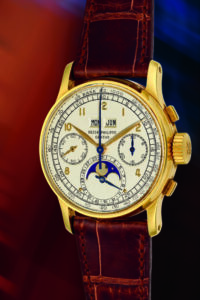A Stunning Auction Outcome: Phillips Breaks Records with $25 Million
The New York Watch Auction XII from Phillips concluded with incredible results surpassing $25 million in sales. This auction not only was a significant financial success; it also marked a historic milestone for the brand, being the ninth consecutive Phillips watch auction in New York achieving what is known as a “white glove” auction—an auction where every single lot is sold. Once again, Phillips achieved this prestigious outcome. The presence of bidders from over 70 countries emphasized even more the global reach and appeal of the carefully curated Phillips auction. That reach and appeal only continues to solidify Phillips’ position as a leader in the luxury watch auction business. For more details, visit Phillips’ The New York Watch Auction: XII Exceeds $25 Million In Sales With 100% Sell-Through.
The event’s success highlighted the intense and burgeoning demand for vintage watches, especially those made by the storied Swiss firms Patek Philippe, Audemars Piguet, and A. Lange & Söhne, as well as by independent watchmakers such as F.P. Journe and Harry Winston. These same watches that topped the event’s results showed their consistent investment value, by besting estimates and proving that (even allowing for some trimming of the overall totals) there was little that was rare, little that was a limited edition, and indeed little that was not an investment unto itself, among the lots on offer.
A High Stakes Bidding War: The Role of Patek Philippe in the Auction
At Phillips’ New York Auction XII, the very first hammer that fell indicated that Patek Philippe would take center stage in this auction’s success. Up first was the Ref. 1518 Perpetual Calendar Chronograph, a watch from 1950. In the auction world, the Ref. 1518 is known as “the one that got away” for its rarity, exceptional condition, and strong desirability. Competition was fierce, and the piece sold for $1,451,500—nearly four times its low estimate of $400,000 and more than double the price of any watch sold at auction before.
This amazing outcome underlined once more the lasting attraction of Patek Philippe timepieces in the luxury watch collecting universe. The Ref. 570 Calatravone, another iconic Patek Philippe model, also had a stellar night, netting $1,066,800. This watch, with its distinctive three-tone Breguet numerals, had drawn much attention and went for more than double its original low ball estimate of $400,000. Quite clear, then, is the brand’s ubiquitous strength in the auction market.
Independent Watchmaking Shines: F.P. Journe and Harry Winston Lead the Charge
Even though Patek Philippe came away from the auction with the most total winning bids, independent watchmakers showed they can command equally impressive sums at Phillips’ prestigious events. F.P. Journe highlighted this fact right off the bat with its new auction record set by the Tourbillon Anniversaire Historique “T30,” which sold for a stunning $889,000. This timepiece from F.P. Journe best represents the remarkable craftsmanship and innovation associated with the name. It’s not hard to see why F.P. Journe is now one of the leading independent watchmakers whose pieces are among the most coveted in the auction world.
Moreover, F.P. Journe’s Répétition Souveraine Smoked Sapphire was sold with an impressive price tag of $685,800 following a bidding war that lasted nearly six minutes. This intense auction battle underscores the growing affection collectors have for F.P. Journe’s complex, rare-timepiece editions, which continue to exceed auction-house expectations.
Phillips’ auction was also marked by Harry Winston’s presence, with its Opus One now holding the record for the series. The unique collaboration between F.P. Journe and Harry Winston fetched $838,200, demonstrating the Opus series’ burgeoning popularity. These bespoke, one-of-a-kind pieces are highly lauded, not just for their aesthetic and artistic virtues, but also for their often mind-bending technological innovations.
Cartier and Rolex Create Surprise Moments with Strong Sales
The auction world was not prepared for what happened when lots from Cartier came up for sale. With almost every lot surging way past its pre-sale estimate, it was a truly remarkable showing for the brand. One of the highlights was definitely the yellow gold Coussin Bamboo “Jumbo,” which sold for more than five times what it was expected to go for. It seems clear that people are really starting to pay attention to the true artistry and craftsmanship of Cartier, especially in those pieces that manage to straddle the line between classic design and modern sensibility.
Moreover, the auction saw a unique addition from Rolex with the sale of a Daytona sporting the “Big Red” logo, once owned by Formula 1 driver Jean-Pierre Jabouille. This watch is significant not only for the distinctive appearance of its logo but also for its association with motorsport, and it brought an impressive $215,900. Collectors certainly had the opportunity to discount for the association between this timepiece with Rolex’s endurance motorsport heritage.
The Bidding Process: Global Interest and Record-Breaking Prices
As New York Watch Auction XII progressed, Phillips showed it was not just about making record prices but also generating thrills. From the start of the auction, it was clear this was much more than an event centered around the exchange of commodities for cash. Bidders were on the edge of their seats, fighting head-to-head for the pieces they oh-so-wanted. There was a huge and happy presence of watch lovers in the room, and each lot of the auction served as another clear testament to the omnipresent allure of horology.
During the auction, expert auctioneers from Phillips directed the bidding, handling the high-stakes demands with their customary professionalism and precision. The ambience in the room was electric—bidders were practically clamoring to raise their paddles for the most sought-after timepieces. Some lots, like the Patek Philippe Ref. 1518, were absolutely insane in terms of the action they drew. And then there was the F.P. Journe portion of the sale, which was equally nuts. On the whole, the auction served as both a bellwether and impetus for the skyrocketing trend that’s seen luxury watch collecting evolve over the last couple of years.
Phillips’ Strategic Positioning: Setting the Stage for Future Auctions

In the luxury watch auction world, Phillips has really made a name for itself. It offers only the finest, most carefully chosen pieces. If you want to know what this auction house stands for, look at its results—they make the picture very clear. Time after time, watch after watch, Phillips has been not just achieving but exceeding what many in the field consider to be the gold standard. And with each new sale, it seems only to add to the very strong head of steam that it has going.
The New York Watch Auction XII reflects Phillips’ capacity to meet an expanding, worldwide, watching-collecting audience. The potential of watches as luxurious, an object worthy of hefty investment, has stirred up a potent market lately, and Phillips stands as a key player in this field.
The Future of Phillips: Increasing Demand and Record-Setting Results
The Phillips New York Watch Auction XII results show how much the demand for rare and exquisite timepieces has escalated. This event, within the context of an already thriving collectible watch market, clearly indicated the event’s strength. More interestingly, perhaps, it also indicated another trend that appears to be developing with some of the recent Phillips watch auctions. Namely, that’s the trend toward consistently achieving record-breaking totals in terms of the amount of money collected in these auction events.
As the market for timepieces grows and changes, Phillips in turn seems to be trying to grow and change to keep its place at the very front of the watch industry, offering—almost in a class by itself—collectors and investors access to some of the most exclusive and valuable watches in the world. The yet-untitled auction scheduled for May 9, 2018, at the Hotel des Bergues in Geneva aphids itself as another golden opportunity for those in the know to score some highly desirable wrist candy.
FAQ: The Key Insights Behind Phillips’ Historic Auction Results
Q1: What sets Phillips’ New York Watch Auction XII apart from others?
A1: Not only did the auction reach a staggering $25 million in sales, but it also achieved a perfect “white glove” result, where every single lot was sold. This underscores the continued demand for rare and vintage timepieces from prestigious brands like Patek Philippe, F.P. Journe, and Cartier. And the international interest, with bidders from over 70 countries, reflects how captivated people are by luxury watches. For more information, visit The New York Watch Auction: XII Highlights and Results.
Q2: Why did Patek Philippe achieve such high prices for its watches?
A2: Patek Philippe has a well-deserved reputation for making some of the most sought-after and valuable timepieces in the world. The Ref. 1518 Perpetual Calendar Chronograph, one of the lots being sold in this auction, is a prime example. Its estimate was $800,000 to $1.2 million. It sold for about $3.8 million. Understand this: 1518s are rare. They were only made from 1941 to 1953. This one is special in that it is the only known yellow gold 1518 with a perpetual calendar, a chronograph, and in the same condition BBS found it in.
Q3: Which independent watchmakers did well at the auction?
A3: The auction featured impressive participations from F.P. Journe and Harry Winston, with F.P. Journe establishing a new auction record for its Tourbillon Anniversaire Historique “T30” and Harry Winston’s Opus One reaching a record-breaking high. This growing demand for independent watchmakers is quite evidently a shift toward appreciating, bespoke, and highly-complicated timepieces.
Author Bio:
A seasoned expert in the watch industry, John Smith has over 15 years of experience in the luxury watch sector, spanning sales, auction strategies, and business development. He is a regular contributor to prestigious watch publications, and his insights carry weight with watch collectors and investors.
